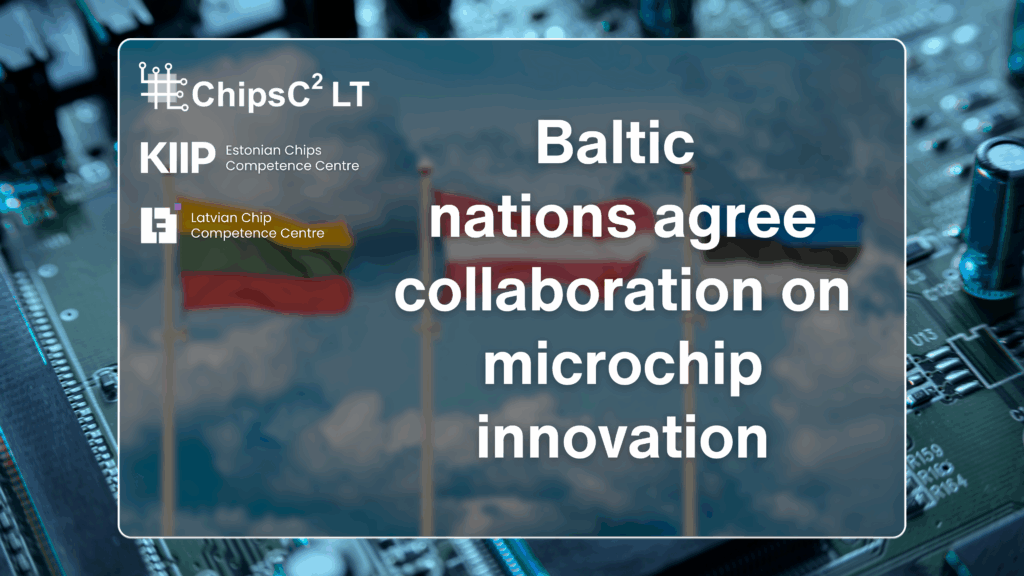Latvia, Lithuania and Estonia have agreed to step up collaboration between their national chips competence centres in the hope that shared expertise and infrastructure will accelerate the development of an innovative semiconductor ecosystem in the Baltic region.
A memorandum of understanding was signed on October 22 by the organisations representing the respective competence centres: Riga Technical University (RTU) and the University of Latvia, Lithuania’s Center for Physical Sciences and Technology (FTMC), and Estonia’s Metrosert Applied Research Centre.
“Each of us brings something different to the table,” Saulius Tumėnas, manager of the Lithuanian chips competence centre, told Science|Business. “Rather than each country trying to build everything and ending up with mediocre capabilities across the board, we’re creating genuine centres of excellence in our respective areas.”
Since the EU Chips Act entered into force in 2023, the EU has co-financed the creation of 27 competence centres in 25 European countries. They provide businesses, especially start-ups and SMEs, with support, training and access to infrastructure, including the pilot lines and design platform supported by the Chips Act.
“The budgets for launching the chip competence centres for the first phase are relatively limited, so we would like to avoid any duplication and reuse the experience, expertise and resources that are already available,” said Andres Mellik, head of the Estonian competence centre.
The partners have agreed to work together on three main areas: joint international representation and investor outreach; shared training programmes, knowledge exchange and access to research infrastructure; and support for start-ups and SMEs to access EU-funded infrastructure.
“We want a start-up in Tallinn to feel like they’re accessing one Baltic competence centre, not three separate national ones,” said Tumėnas. “That means unified service offerings, compatible pricing and streamlined access to equipment, regardless of its location.”
The competence centres will also discuss financing issues as they strive to ensure their activities are sustainable once the four-year EU funding expires.
Looking for niches
The idea is to target specific areas where Baltic countries could play a role in developing cutting-edge technologies.
For Latvia, that means focusing on photonics, quantum and artificial intelligence. RTU already has strong research expertise in photonics, a growing subsector of semiconductor technologies that manipulate photons, or light particles, in contrast to electronic chips which manipulate electrons. “There’s a lot of development required to transfer this to a start-up ecosystem,” said Jānis Sperga, semiconductor strategy manager at RTU.
Lithuania also has a strong foundation in photonics, specifically lasers and optoelectronics. Its competence centre will focus on chip design, power electronics and heterogeneous integration, which involves packaging smaller components into a single chip.
In recent years, Lithuania has strengthened its ties with Taiwan, resulting in the establishment of a joint laser research and innovation centre on the island and joint activities between Lithuanian and Taiwanese universities.
Estonia meanwhile plans to tap into Tallinn University of Technology’s expertise in semiconductor testing and verification. Focus areas include chip security, for chips that are tamper-proof and not copyable.
The Estonian competence centre wants to “take the fear away from the industry,” by showing companies that it is possible to develop their own chips and by “walking them through the whole journey,” said Mellik.
It is hoped that combining these different strengths will also lead to new projects and start-ups that wouldn’t otherwise exist. “Imagine a power management chip from Lithuania with Latvian photonic components, verified with Estonian security frameworks,” said Tumėnas. “That’s a real value chain, not just cooperation on paper.”
Baltic ecosystem
Semiconductors are seen as a key economic driver that will attract investment and stimulate innovation. “You cannot really develop an innovative deep-tech ecosystem without having a good cornerstone in semiconductors nowadays,” said Sperga.
For the Baltic countries, each of which shares a border with Russia, resilient supply chains are also a key concern when it comes to chips, which have important defence and security applications.
The collaboration is currently a bottom-up initiative driven by the representatives of the competence centres. “Hopefully, as we develop stronger ties, and as we have success stories from our collaboration, this will also influence the political alignment regarding semiconductors and the deep-tech innovation space more generally,” said Sperga.
The countries are currently awaiting the outcome of a joint Horizon Europe proposal to map the regional semiconductor ecosystem. This will allow them to identify their respective strengths and weaknesses and could be a first step towards more joined-up national strategies in the future.
Meanwhile, the aCCCess initiative, a coordination and support action launched in March 2025 under the EU Chips Act, is aiming to strengthen collaboration between competence centres across Europe and with the Chips Act pilot lines and virtual design platform.
For Sperga, the Baltic alliance is a logical first step that will make it easier to collaborate with larger markets in the EU. For example, the competence centres have held discussions with their counterparts in the Nordic countries over a future Baltic-Nordic semiconductor alliance.
The organisations behind the Baltic collaboration believe it will also provide clearer value for potential partners outside of Europe.

